Primary Sources
Primary Sources

Teachers, need a primary source to create a lesson in the classroom? Students, need a source for a research project?
Here, we've listed the primary sources featured in our Unit Plans. Click on a primary source to go to its page, where you may find additional images, transcriptions of the text, a citation guide for including the source in a bibliography, or ways to purchase copies of the source for the classroom.
HSP's collections are not limited to the primary sources listed here. To see all that HSP has to offer, come visit us or explore our collection online through the Digitial Library and the Discover online catalog.
Some sources have handwriting that is difficult to read. If you need help decoding handwriting, check out this guide from Ancestry.
 At the time of the Civil War, the local volunteer militia was only allowed to serve three months out of a year. This illustration is refferencing that by showing the man coming home, yet assuring his family he will return to the militia soon. |
 This illustration compares the 1860 Presidential Race to Baseball. Baseball was a popular sport, even in the 1800s, although the rules were slightly different than today. In the cartoon, President Abraham Lincoln is the only candidate to score a "run" and he is carrying a rail, not a baseball bat. |
 This cartoon is in reference to President Andrew Johnson's Reconstruction policies, particularly pardoning Confederates. |
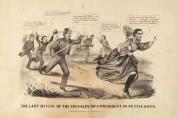 Jefferson Davis is running away from oncoming soldiers after the Confederacy surrendered. |
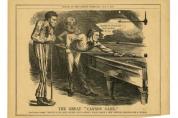 This cartoon was created after the Battle of Chancellorsville, somtimes considered General Lee's greatest victory. |
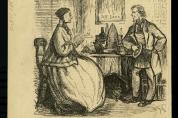 This cartoon is mocking women who live in the North, yet are Southern sympathizers. |
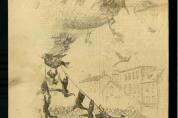 This is an image from the Civil War depicting men attempting to dodge the draft. Many people were against conscription, particulary immigrants, since they felt they were not involved in the politics that led to the Civil War. Two days after this cartoon was published, there was a draft riot in Wisconsin. |
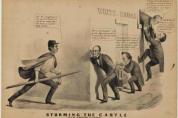 This cartoon is from the 1860 election and it depicts President Abraham Lincoln coming into the White House while Stephen Douglas attempts to break in. President Lincoln is holding a rail because he was sometimes referred to as the "Rail Splitter." |
 This cartoon was created at the beginning of the Civil War to illustrate that the Union would not fall to the South. The donkey, named South Carolina, cannot pull down the Union. |
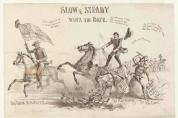 Created during the 1864 Presidential Election, Lincoln is surpassing McClellan who can no longer keep a hold on his horses. The horses represent the policies of the candidates, and it shows McClellan juggling too much at once. |
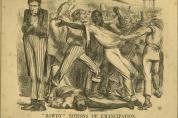 This cartoon illustrates President Lincoln turning a blind eye to the New York City draft riots of 1863. |
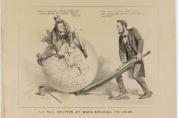 President Lincoln was referred to several times at the "Rail Splitter" due to his prior work experience with splitting rails. Although it was only his job for a short time, the nickname stuck as it appealed to working class men to see the President as a man of the people. |
- ‹ previous
- 7 of 22
- next ›
